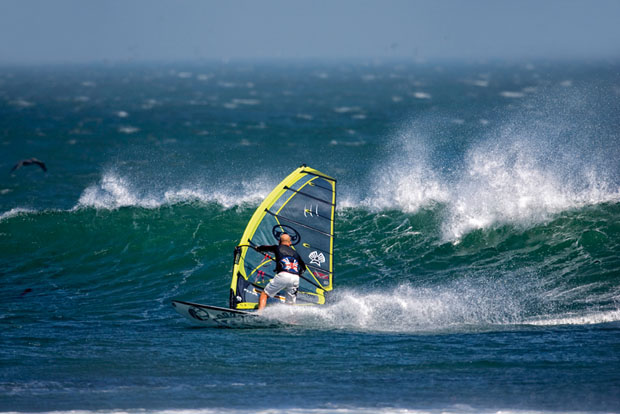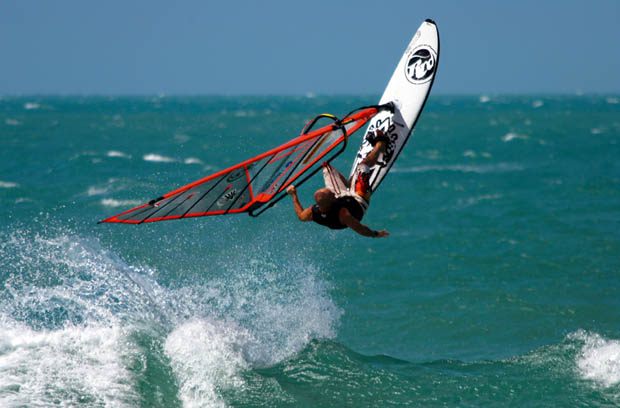In this instalment of Jem’s comprehensive series examining every aspect of wavesailing, Jem Hall guides us through the component parts of another form of aerial assault…
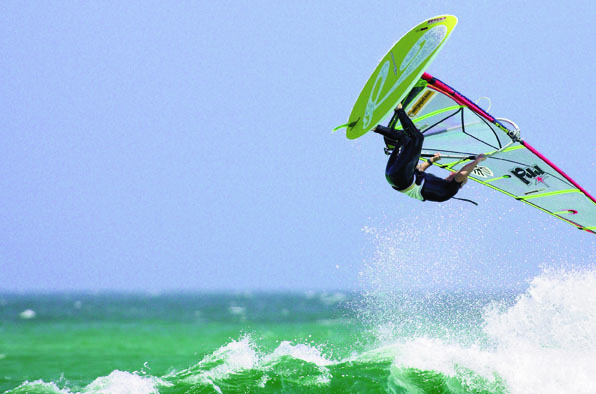
I’m very happy to say that the tide is definitely turning, as I’m hearing about and witnessing many more people going for forwards, and more loopers are approaching me to coach them through themove. The fear is being controlled and lots of sailors are really up for it. This is great news, as once you get the forward your confidence grows and you will be looking for new aerial challenges. Well, you need look no further, as the back loop should be very much on your agenda. The back loop really doesn’t need a detailed introduction as we see it being banged out at good wave locations everywhere and on many fine windsurfing movies. (We even see it being attempted by people trying to avoid confronting their front loop demons by saying “Well, I go for the occasional backie…” But that’s a different story.)
Backing It Up
It is THE jump. All pros love the back loop, and good sailors who can do it love it from their first to their hundredth. When you can pull off back loops and make high, CLEAN forwards you are a very accomplished jumper indeed, even more so if you can do them on both tacks. If you sail at a location that isn’t blessed with great riding conditions, then having jumping competency will help you bide your time until those joy riding days come. The beauty of the back loop is you can always strive for more, be it in terms of height, consistency or difficulty – e.g. dropping a hand or a leg. But the backie is also a beast. You can have it and then it gets away from you – and the conditions have to be just right. It requires a different technique as the wind strength changes, or as your angle to the wave changes. Let’s look at the move more closely now, using the same formula we employed to examine the fundamentals of the forward – our good old ‘what, where, when, who and why’.
What? It’s a move in three parts: vertical jump, rotation through the wind at the apex, and then the landing, which is nose-first and on a downwind course.
Where? Off good steep ramps. Wave selection is very important, and hitting the pocket of the wave is ideal. This is next to a breaking section and therefore has plenty of power. Cross-on to cross-shore winds are best, although it is do-able in onshore wind.
When? When you have the right conditions and aren’t too overpowered. Do it when you are fresh in your first hour of sailing. Have a session on it of 30-45 minutes and no more. Ensure you have competency in vertical jumps and nosefirst landings. Hunt for your ramps, as this is all part of it – the right jump off the right ramp!
Who? Anyone who is jumping vertically, has control in the air, and can land nose-first. You will also need height, as this gives us that most valuable commodity – time.
Why? It’s the best feeling ever after having mastered the forward. And it gives you a different jump to work on when confronted with steeper ramps. It’s the definitive performance jump.
As for the ‘how’ – we’ll go through the full sequence in another article.

Nose Firsties:
As you’re coming down from your back loop, having rotated through the wind at the apex of your steep jump, you will be required to land nose-first and with a bit of power in the rig. Backies are just like puppies; a wet nose is a happy nose. So it’s vital that you have the nose-first landing in your jumping armoury. These days we see most regular jumps landed tail-first, and rightly so as it’s easier and lowers the possibility of going over the handlebars on landing. Nose-first landings used to be a lot more commonplace – perhaps because old-school boards could only plane out of jumps with the skimming effect of landing nose-first. Modern shortboards plane so much easier that you can have a heavy tail-first landing and still get away planing. So let’s bring back some nose-first landings please.
Why?
Because…
• When jumping over whitewater theywill keep up your speed and you will thus be more likely to make it out the back.
• They equip you with an exit point from your back loop landing.
• You will have more control on over-rotated forwards where you land nose-first.
• They look cool.
I will cover the move more thoroughly in a later issue, but for now let’s look at the main tips.
From your tail-up jumping in-flight control stance, direct a bit more pressure through your front arm and front leg while sheeting out slightly on the back hand. This will drop the nose as your body stays back while you look forward to spot your landing As you’re just about to land, open out your back hand to sheet out and ensure your weight is moving back with the nose down and just about to touch the water. On landing you’ll want to head upwind slightly by continuing to sheet out and weighting your heels while you glance upwind. If you don’t do this, then with your nose down and all the leg-scissoring action in the air you’ll be on a downwind course and ripe for a trip over the handlebars!

Vertical Jump Sequence
Previously I’ve been getting all bald about tail-up jumps so you can plane out of your landings and be ready for those forwards, and now I want you to get all vertical. Confusing, I know, but it will make sense in the end.
Once you’ve gone vertical in a big jump there will be a portion of getting the tail up just before you land to ensure a smooth touchdown. When we talk about ‘vertical jumping’ it describes the wave we have taken off from and the fact that the board has its nose high and tail low with you beneath the kit in a position to control it and ready to lift and rotate it through the wind, should you so require.
While working towards the forward, it’s all about tail-up jumps, tail grabs and wymaroos. The back loop requires you to be able to get as much height and control in a vertical trajectory, and then at the apex start rotating and coming through the wind. Therefore you should aim to get really proficient at vertical jumps.
The height you get in these jumps depends on your boardspeed, the strength and lift of the wind, and the size and power of the wave from which you take off. When trying to attain more height, it’s commonplace to bear off for speed before your ramp and then head upwind as you approach the steepest part of the wave for take-off. So, while you need to search for waves to catch while out at the bus stop waiting for a ride, you also have to spot potential vert ramps from 50 to 200m away. What was that mantra? Right move, right time, right place – and in the right way!
All this height and control will give you what we all want – time – and, just as important, confidence. So let’s get you high and vert.
Vertical Jumping Sequence
Cross-on wind and 5.2m Ezzy with RRD Wave Cult 84, waist to shoulder-high waves with a couple of peaks that always throw up steeper ramps in the same position. I’m aiming to hit this area with good speed so when the ramp jacks up I will take its power and the wind’s lift to project me skywards.
1. Spot the ramp from a good distance away, and after bearing away for speed head upwind just before you hit the ramp to bring the power back into the sail. Sheet out to get the nose up and start to lift on the front arm and leg while your weight moves back.
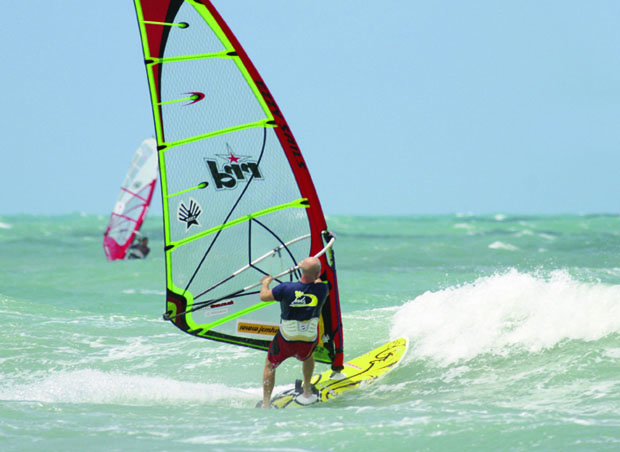
2. With your weight moving back over the back foot and the front arm and leg lifting up, you’re already projecting the nose skywards. The closer together your hands are here and the more you look up, the higher you will go. Yep – where you look is where you go, so look up and look high.

3. As the nose rises, get compact by bringing the rig in close and dropping your arse back over a bent back leg while the front leg starts to straighten.
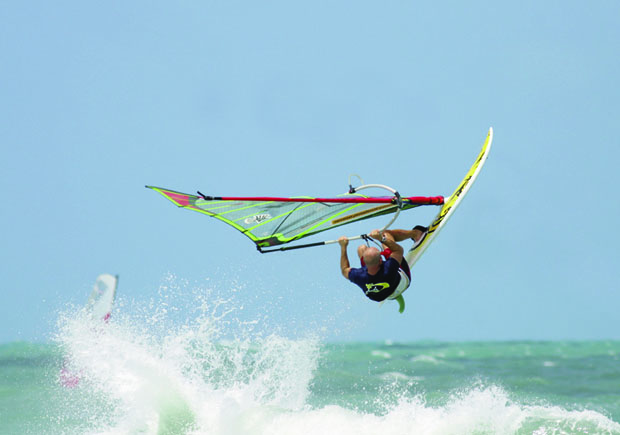
4. Lifting up even further on the front arm and pointing the front leg will get your nose up as your arse is back over the tail.

5. It’s here at the apex that you can start to have a look into the wind over your front shoulder to feel the board turning through the air. Aim to get in a really comfy compact stance in this position so you can control the kit from buffeting by the wind and be ready to go into your backie should you so require.

6. As you come down, aim to level off into a more horizontal plane ready to get that tail up for a soft and efficient landing.
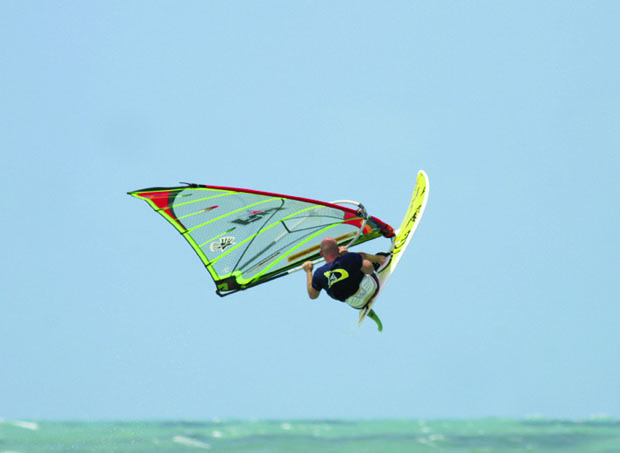
7. Push down through the front arm and front leg to drop the nose as you pull the tail up.
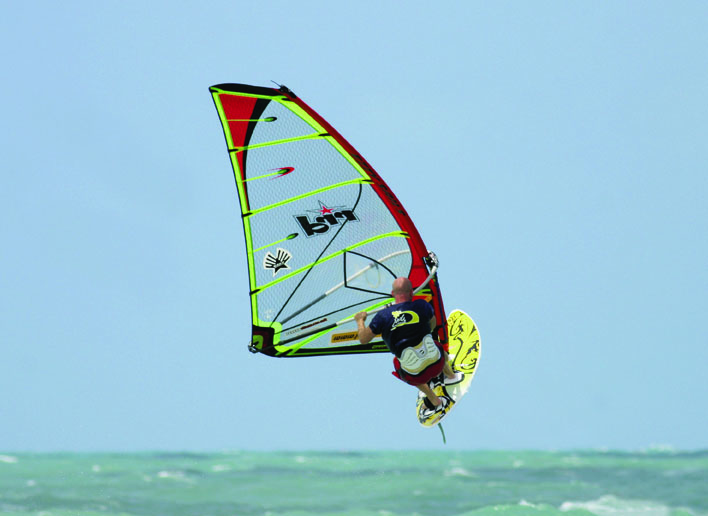
8. As you get closer to the landing that you’ve spotted, start to sheet out and drop the tail.

9. Land with the back leg bent and sail sheeted out so you’re ready to power up and plane off. After landing, throw the rig open and scissor your board off the wind slightly as you weight your toes to flatten the board and thereby aid your getaway.
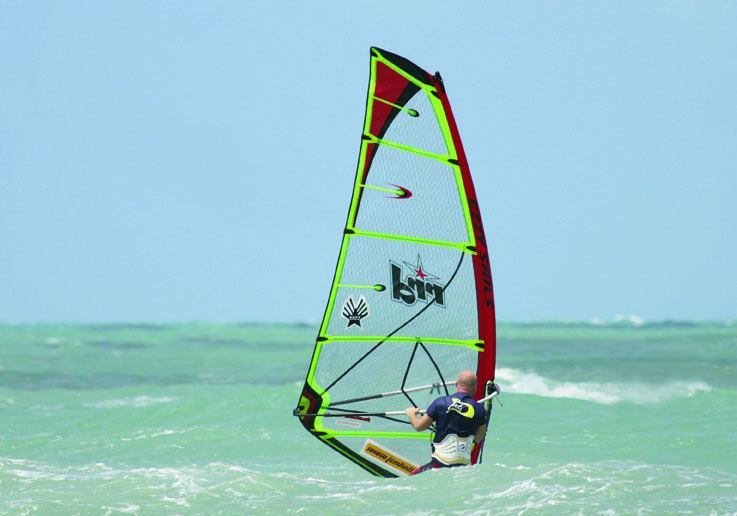
Practise this a lot. Aim to get higher and more in control during every session, and when you start to feel like you have time up there then you’re ready to go for some SUBTLE rotation as you work towards the back loop. Enjoy the view.
Skye High and Vert:

Let’s glean some info from my good man Skyeboy (and I would also like to say that this article has also been founded on great tips from Andy King and James Cox).
Over to John: “Firstly, be ready for a long learning experience. Back loops for me were the hardest of all jumps. I think I must have done at least a thousand attempts before I actually landed one and sailed away. For me the trick was to under-rotate at first and slowly try to add a little more rotation with each attempt until I eventually got it right.”
“The way I do it is to try to jump high and vertical and then stop at the top, sheeted out and just about to go through the wind. At this point you look over your shoulder and REALLY LOOK for the landing spot. If you don’t really focus on the landing it is hit and miss whether you land or not.”
Thanks John, that was our reality check and makes us realise it is a tough move, but the only limits placed on you are the limits you place on yourself, so let’s work towards nailing that backie. Looks like we’ll need to be vertical jumpmasters and able to spot our nose-first landings, which is why I’ve covered both these in detail.
Hall’s Homework:
It’s all about positive use of your valuable time. Winter can bring big swell and great conditions, so get out there and start racking up those vertical jumps and nose-first landings. Along with your New Year resolutions, really commit to be strong, flexible and fit as you aim to master the sea. Get some swimming in because you will need to get to your kit on those big days, and the fitness gained will help you in your learning as well as improve your surfing and/or stand-up paddleboarding.
“Its not who you are underneath, it’s what you do that defines you.” -BATMAN. (…classic)

Jem Hall is sponsored by RRD Boards and Ezzy Sails, Pro Limit, Grasshopper Porridge and his site www.jemhall.com is sponsored by Oceansource.net.
Jem’s new technique movie Beginner to Winner is out now. If you seriously want to improve and have a fantastic holiday, book one of his ’10 coaching clinics now!
John Skye is sponsored by F2, Naish Sails & Helly Hansen. John has was coached by Jem during their time in Team Fakefish.


